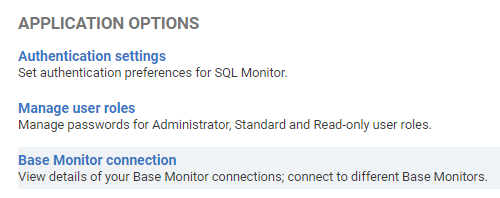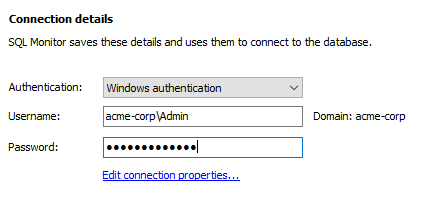Changing the Base Monitor connection
Published 08 March 2018
The base monitor (also called the monitoring service) service account is the Windows account you specified during installation to connect to the SQL Monitor database (the SQL Server database that stores all collected data). For more information, see
If you want to to disable the machine where the base monitor service is running, but don't want to stop monitoring data, you can install the base monitor on another machine and change the connection in SQL Monitor.
Configuring the base monitor connection
In the Configuration tab, under Application options, select Base Monitor connection:
Installing the base monitor on another machine
- Click the base monitor installer link to download the SQLMonitorBaseMonitorInstaller.exe file.
- Run the .exe file. Click Next to display the Set up Base Monitor page.
- Specify where to install the files that will run the service.
- Select a TCP port to use for communicating with the web server and the data repository. Click Next.
- By default, the SQL Server database set up when you installed will still be used as the data repository. If you're happy to continue using this, go to the instructions below on Connecting to the database.
Creating a new database for the data repository
- Click Select database and then select Create a new database.
- Click Next, then enter the SQL Server instance name.
You can type an instance name or IP address directly into the SQL Server box if the instance name does not appear in the drop-down list. - By default, SQL Monitor will create a database called
RedGateMonitor. To use a different name, in the Database box, type a name for the database. - Under Create database using, one of the following:
- Use current credentials to use the account that you are currently logged into.
- Specify an account. If you select Windows authentication, SQL Monitor assumes this account is in the current domain. To use a different domain account, enter credentials in the format username@domain-name or domain-name\username. Enter the password.
The specified account must have Create Database permissions.
- Click Create Now to create the database. Once database creation has been confirmed, click Close. If you go back a page in the wizard, this will not undo the creation of the database.
The database is created using all the default settings for creating a new database on the SQL Server instance you selected. If you encounter an error message when creating the database, see Account credentials required.
Using an existing database for the Data Repository
You should only use an existing database if you want to create the database outside of the SQL Monitor installer using a SQL Server management tool, in order to specify options such as filegroups, autogrowth, and so on.
To specify your Data Repository database:
- Click Set Up Data Repository and then select Use an existing database.
- Click Next, then select the SQL Server instance.
- In the Database box, select the database you want to use; databases on the SQL Server should be automatically detected, and appear in the list.
You can type an instance name or IP address directly into the Server box if the instance name does not appear in the drop-down list. - Click Next. SQL Monitor checks the database. Once the database connection has been confirmed, click Close.
If you encounter an error message when connecting to the database, see Account credentials required.
Connecting to the database
The Base Monitor service requires credentials to connect to the database you just specified in order to store and retrieve collected data. This account must have administrator privileges on the database.
Windows authentication
If you connect to the database using Windows authentication, the Windows account you select will also be used to run the SQL Monitor base monitor service. If the account doesn't have permissions to run a Windows service, then it will be granted these permissions.
The user name defaults to your current domain. You can change the domain in the User name box using either of the following formats:
- mydomain\username
- username@mydomain
SQL Server authentication
You can connect to the database using SQL Server authentication. If you provide SQL Server login credentials, the base monitor service will run under the Local Service account.
Read more information about the Local Service account.
Error reporting
SQL Monitor can send data to Redgate about the features you use and any application errors you encounter. This helps us to improve SQL Monitor for future releases.
All data is anonymized before we receive it, and no confidential information is sent to us.
If you are happy to allow this data to be sent, select Send error reports, and optionally enter your email address. We will only contact you in the event of an error for which we require further information, to help us eliminate bugs.
Summary
- Review all your installation options on the Summary page. If you want to change anything, use the Back button to edit the required page. Once your database for the data repository has been created, it won't be deleted if you go back and set up a different Data Repository.
- Click Install to start installing SQL Monitor using the selected settings.
- When installation has completed, click Finish to launch SQL Monitor.
To start using SQL Monitor, you first need to create a password to use when logging in to the SQL Monitor pages.
Changing the base monitor connection
Once you've installed the base monitor on another machine, you can change the connection:
- Using SQL Monitor Website, go to Configuration > Base Monitor connection.
- Enter the full domain name or IP address for the machine that has the base monitor installed on it.
- Select the TCP port you specified during installation to use for communicating with the web server and the data repository.
- Click Save connections.






